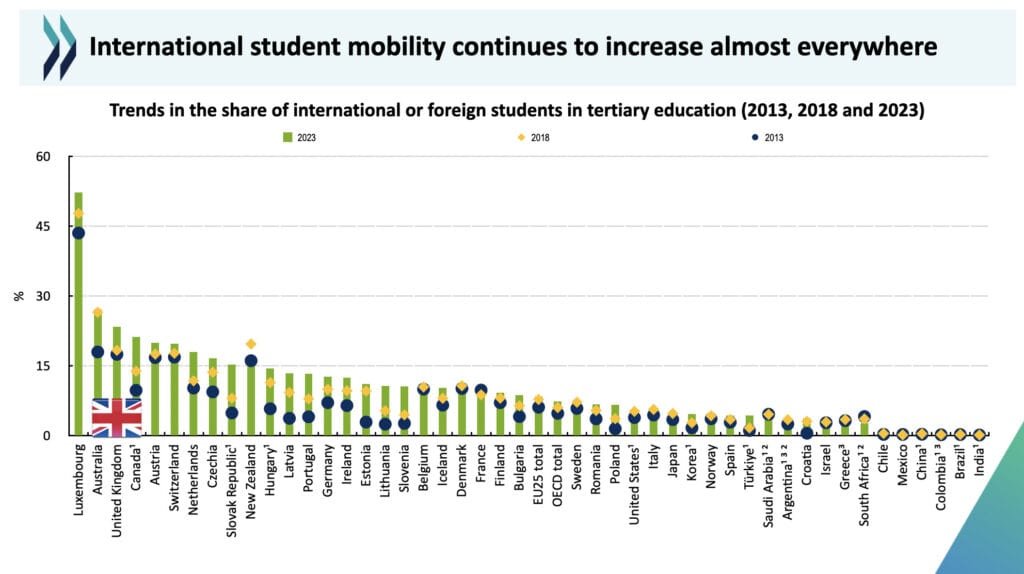Education
International students in UK double over past decade

International student mobility has continued to grow across nearly all OECD countries, with the US, UK and Australia hosting the highest number of international students in 2023, the OECD’s Education at a Glance 2025 report has shown.
“The growth of international student mobility across OECD countries is good news,” said Pamela Baxter, IELTS managing director at Cambridge University Press & Assessment, at a Higher Education Policy Institute (HEPI) event on September 9 which marked the launch of the report.
“It is especially pleasing to find that the UK continues to be one of the most attractive destinations for international students – second only the US,” added Baxter.
As a share of the overall student population, Luxembourg (52%), Australia (27%) and the UK (23%) were found to have the highest proportion of international students, compared to an OECD average of 7%.
Despite slowing in recent years, the report found global educational attainment reached an all-time high in 2023, with nearly half of young adults in OECD countries now completing tertiary education – up from 27% at the turn of the century.
Speakers hailed the UK’s more than doubling of its international student population over the past decade as an endorsement of the quality of higher education, as well as commending the country’s relatively low university dropout rates.
And yet, the report also exposed “sad truths” that the UK is performing “relatively poorly” when it comes to outcomes for lower-skilled learners and the proportion of young men out of education or employment, said HEPI director Nick Hillman.
In the past decade, international student numbers across the OECD have risen by 72%: from roughly three million in 2013 to more than five million in 2023.
“While there is one international student for every three home students in the UK, across the OECD as a whole the ratio is completely different at 1:13,” said Hilman, unveiling the data.
“From the vantage point of the OECD in Paris, this is a real UK success story – though the Home Office continues to push for policies to reverse recent trends,” he continued.
Unlike its predecessor, the current Labour government has repeatedly paid lip service to the value of international students to the UK, but policies have not always aligned with the rhetoric.
This spring, the government published its highly anticipated immigration white paper which proposed shortening the graduate route, implementing stricter compliance metrics for universities, and imposing a 6% levy on the income from international student fees.
Speaking at the report’s launch event, the UK’s recently re-appointed minister for skills Jacqui Smith said the government was “proud to be a leading destination for international students,” with a 15% market share amongst OECD countries.
“We will remain committed to welcoming genuine high calibre international students to study in the UK and ensuring that our higher education system continues to be world class,” said Smith, acknowledging the “considerable investment” they’re asked to make.
Across the OECD, England has the second highest tuition fees for master’s programs, after Lithuania and followed by the US, Canada and Australia, the report revealed.
What’s more, while a relatively high percentage of the UK’s GDP is invested into education, the country has one of the lowest shares of public funding in tertiary education, which has fallen significantly since 2015.
Hundreds of thousands of international students are attracted to the UK each year and they prop up the system via their high fees
Nick Hillman, HEPI
Amid steep financial challenges facing UK higher education, Hilman suggested the system placed “perhaps too few expectations on taxpayers” with international students increasingly relied upon to “prop up the system via their higher fees”.
The data highlighted the value of tracking mobility trends which “serve as important signals about the attractiveness of national education systems and their ability to integrate diverse student populations.”
As of 2023, approximately 46% of OECD international students studied in the US, UK, Australia or Canada, with policy disruption across traditional destinations causing the rise of emerging destinations outside the ‘big four’.
According to OECD director for education and skills, Andreas Schleicher: “It’s no longer just the English-speaking countries” that are attracting large volumes of international students, pointing to the decline of the US in relative terms, whose international student population comprised roughly 5% of higher education enrolments in 2023.
Among non-English speaking countries, France, Germany, and Türkiye each take about 5% or more of the total share of international students across the OECD.
In terms of source countries, students from Asia remain the largest regional group of international students, making up 58% of the OECD total in 2023.
Education
Ram Chella – Colleges Of The Future: AI Transforming Education And Employability

Q. How do you see the shift in approach in higher education with AI becoming an integral part of the workspace and learning?
Education in India is standing at an inflection point. For decades, colleges have measured success by degrees awarded, not by the employability of their graduates. But in the age of artificial intelligence (AI), that equation is being rewritten.
The next generation of top 100 colleges to watch will not be the ones that fear AI. They will be the ones that integrate AI elegantly into their workflow—enhancing learning, improving knowledge retention, and producing students with ‘Proof of Readiness’ rather than just certificates.
Traditional classrooms focus on theory. Employers, however, demand proof. The new model of education flips the script: students are trained and assessed in AI-powered practice environments that validate not just what they know, but how ready they are to perform.
From ‘Degrees to Data-Backed Readiness,’ this shift has far-reaching impact. For students it means higher retention, greater confidence, and stronger employability; for colleges it is a decisive move from degree-centric to outcome-centric reputations; for India it is the ability to uplift 100 million learners at scale, fueling national competitiveness.
Q. Could you share a few examples as ‘a case in point’ that are becoming ‘Colleges of the Future’?
Across India, pioneering initiatives are breaking away from the monotone of certificates and resumes. They are proving that employability in the AI era means readiness, not paperwork:
-
AICTE (All India Council for Technical Education) is redefining how education meets industry. Instead of only accrediting degrees, AICTE is actively integrating AI to match students with industry needs—focusing on skills, outcomes, and readiness rather than just certificates.
-
SWAYAM Plus is shifting from being a digital catalogue of courses to becoming an AI-enabled readiness platform, where learners don’t just “complete” modules but demonstrate skills mapped to real employer demand.
-
Apna Jobs has already powered 7 lakh+ interviews through AI-driven skill-matching, eliminating the inefficiency of resumes. By using AI to perform the “non-scalable” tasks—connecting people with the right opportunities at scale—Apna is showing how technology can redefine placements.
These aren’t just incremental improvements. They represent a systemic break from the past—moving India’s education ecosystem from certificates and resumes to data-backed readiness and employability.
Q. Given the urgency of ‘now,’ why does AI-integrated learning matter beyond campuses?
The push for transformation is not just coming from students or regulators. It is being demanded by employers who are struggling to find talent that is not only qualified on paper but genuinely ready to perform on ‘Day One.’ Hiring managers across IT, BFSI, and manufacturing echo the same frustration: traditional degrees tell them what a student has studied, but not whether that student can actually deliver results.
AI-powered readiness models solve this gap. By validating practice, fluency, and applied skills, they give companies the confidence to hire faster and at scale. It isn’t just good for employers—it’s essential for India’s competitiveness.
Consider the numbers: India produces nearly 1 crore graduates every year, yet industry studies show that less than 30% are considered employable. Closing this gap is not an academic issue; it is an economic emergency. If even 10% more graduates enter the workforce job-ready, the productivity impact could add billions to India’s GDP annually.
This is why the ‘Colleges of the Future’ are not waiting. They are breaking free from the monotone of certificates and resumes, proving that readiness is the new currency of employability.
Q. What is the big picture in your opinion?
The overarching scenario is that it is not about survival. This is about transformation at scale. The future of India’s workforce depends on how boldly higher education institutions embrace AI—not as a threat, but as a partner. In fact, the foundation should start at the school level.
And as we celebrate these Colleges of the Future, we set the stage for a new era where education does not end with a certificate. It ends with readiness for the world of work.
Education
Best UK universities for electrical & electronic engineering – league table

Engineering of electrical and electronic systems, microelectronics, silicon devices and nanotechnology
Education
Best UK universities for economics – league table

The study of what influences income, wealth and wellbeing, and how this can be implemented into policy
-

 Business2 weeks ago
Business2 weeks agoThe Guardian view on Trump and the Fed: independence is no substitute for accountability | Editorial
-
Tools & Platforms1 month ago
Building Trust in Military AI Starts with Opening the Black Box – War on the Rocks
-

 Ethics & Policy2 months ago
Ethics & Policy2 months agoSDAIA Supports Saudi Arabia’s Leadership in Shaping Global AI Ethics, Policy, and Research – وكالة الأنباء السعودية
-

 Events & Conferences4 months ago
Events & Conferences4 months agoJourney to 1000 models: Scaling Instagram’s recommendation system
-

 Jobs & Careers2 months ago
Jobs & Careers2 months agoMumbai-based Perplexity Alternative Has 60k+ Users Without Funding
-

 Podcasts & Talks2 months ago
Podcasts & Talks2 months agoHappy 4th of July! 🎆 Made with Veo 3 in Gemini
-

 Education2 months ago
Education2 months agoVEX Robotics launches AI-powered classroom robotics system
-

 Education2 months ago
Education2 months agoMacron says UK and France have duty to tackle illegal migration ‘with humanity, solidarity and firmness’ – UK politics live | Politics
-

 Podcasts & Talks2 months ago
Podcasts & Talks2 months agoOpenAI 🤝 @teamganassi
-

 Funding & Business2 months ago
Funding & Business2 months agoKayak and Expedia race to build AI travel agents that turn social posts into itineraries





















